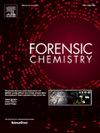Elemental and isotopic profiling of potassium perchlorate salts for forensic explosives investigations
IF 2.6
3区 医学
Q2 CHEMISTRY, ANALYTICAL
引用次数: 0
Abstract
This study explores the feasibility of using isotopic and elemental signatures for the source attribution of potassium perchlorate (KClO4) salts, which can play a significant role in forensic explosives investigations. A total of 41 different reference KClO4 batches were analysed using isotope ratio mass spectrometry and inductively coupled plasma – mass spectrometry. Rubidium was the only elemental impurity detected consistently across all reference batches. Combined with the oxygen isotopic composition, these features provide a discriminating power of 94 %. A score-based likelihood ratio (LR) system was developed also including concentrations of sodium, magnesium, chromium, and iron, which were detected in 69–98 % of the reference samples and showed significant variation between sources. The LR system employs Manhattan distance and kernel density estimation to model (dis)similarity across source comparisons. Five-fold cross validation results suggest the LR system effectively distinguishes between same-source and different-source pairs (Cllr = 0.184) and can be used to report LR values of up to 74 (moderate support). Infrequently detected trace elements and chlorate concentrations allow for a more comprehensive interpretation of chemical profile analyses and should also be considered to uphold forensic integrity. A series of tests have established a reliable method for the reduction of KClO₄ to KCl for subsequent chlorine isotope ratio – mass spectrometry (δ37Cl -IRMS) measurements, which could provide additional discriminating power. Further research is required to develop a scalable process that yields sufficient material for δ37Cl-IRMS and to ensure that the sample preparation process yields reproducible δ37Cl values.
法医炸药调查用高氯酸钾的元素和同位素分析
本研究探讨了利用同位素和元素特征分析高氯酸钾(KClO4)盐来源归属的可行性,这将在法医爆炸物调查中发挥重要作用。采用同位素比质谱法和电感耦合等离子体质谱法对41批不同的KClO4参比进行了分析。铷是唯一在所有参考批次中一致检测到的元素杂质。结合氧同位素组成,这些特征提供了94%的鉴别能力。建立了基于分数的似然比(LR)系统,包括钠、镁、铬和铁的浓度,在69 - 98%的参考样品中检测到,并且在来源之间显示出显着差异。LR系统采用曼哈顿距离和核密度估计来模拟跨源比较的(非)相似性。五重交叉验证结果表明,LR系统可以有效区分同源和不同源对(Cllr = 0.184),并可用于报告LR值高达74(中等支持)。很少检测到的微量元素和氯酸盐浓度允许对化学剖面分析进行更全面的解释,也应考虑维护法医的完整性。一系列试验建立了一种可靠的方法,将KClO₄还原为KCl,用于随后的氯同位素比-质谱(δ37Cl - irms)测量,可以提供额外的判别能力。进一步的研究需要开发一种可扩展的工艺,以产生足够的δ37Cl- irms材料,并确保样品制备过程产生可重复的δ37Cl值。
本文章由计算机程序翻译,如有差异,请以英文原文为准。
求助全文
约1分钟内获得全文
求助全文
来源期刊

Forensic Chemistry
CHEMISTRY, ANALYTICAL-
CiteScore
5.70
自引率
14.80%
发文量
65
审稿时长
46 days
期刊介绍:
Forensic Chemistry publishes high quality manuscripts focusing on the theory, research and application of any chemical science to forensic analysis. The scope of the journal includes fundamental advancements that result in a better understanding of the evidentiary significance derived from the physical and chemical analysis of materials. The scope of Forensic Chemistry will also include the application and or development of any molecular and atomic spectrochemical technique, electrochemical techniques, sensors, surface characterization techniques, mass spectrometry, nuclear magnetic resonance, chemometrics and statistics, and separation sciences (e.g. chromatography) that provide insight into the forensic analysis of materials. Evidential topics of interest to the journal include, but are not limited to, fingerprint analysis, drug analysis, ignitable liquid residue analysis, explosives detection and analysis, the characterization and comparison of trace evidence (glass, fibers, paints and polymers, tapes, soils and other materials), ink and paper analysis, gunshot residue analysis, synthetic pathways for drugs, toxicology and the analysis and chemistry associated with the components of fingermarks. The journal is particularly interested in receiving manuscripts that report advances in the forensic interpretation of chemical evidence. Technology Readiness Level: When submitting an article to Forensic Chemistry, all authors will be asked to self-assign a Technology Readiness Level (TRL) to their article. The purpose of the TRL system is to help readers understand the level of maturity of an idea or method, to help track the evolution of readiness of a given technique or method, and to help filter published articles by the expected ease of implementation in an operation setting within a crime lab.
 求助内容:
求助内容: 应助结果提醒方式:
应助结果提醒方式:


